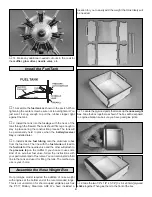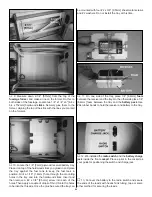
At this stage the model should be in ready-to-fly condition
with all of the systems in place including the engine, landing
gear, covering, and the radio system. The PT-17 Military
Stearman ARF is a short-coupled airplane, making it nearly
impossible to balance without the addition of some nose
weight. Earlier you installed a box to hold lead. Remove the
spinner and cowl. Remove the cover from the box and install
lead. Great Planes (GPMQ4485) “stick-on” lead works well.
All of our prototypes had an O.S.
®
.91 four-stroke engine and
required approximately 18 oz. of lead. This should be a good
starting point for balancing your plane too. After putting the
lead in the box be sure to re-install the cowl, spinner and
propeller. After you install nose weight, pack the inside of
the box tight with foam rubber to prevent any lead from
coming loose and rattling around inside the box.
❏
1. Use a felt-tip pen or 1/8" [3mm] wide tape to accurately
mark the C.G. on the bottom of the top wing (on both sides
of the fuselage.) The C.G. is located 5-1/2" [140mm] back
from the leading edge of the top wing.
❏
2. With the wing attached to the fuselage, all parts of the
model installed (ready to fly) and an empty fuel tank, lift it at
the balance point you marked.
❏
3. If the tail drops, the model is “tail heavy” and the
battery pack and/or receiver must be shifted forward or
weight must be added to the nose to balance. If the nose
drops, the model is “nose heavy” and the battery pack
and/or receiver must be shifted aft or weight must be added
to the tail (or removed from the weight box) to balance.
❏
4. IMPORTANT: If you found it necessary to add any
weight, recheck the C.G. after the weight has been installed.
❏
1. With the wings level, have an assistant help you lift the
model by the engine propeller shaft and the bottom of the
fuse under the TE of the fin. Do this several times.
❏
2. If one wing always drops when you lift the model, it means
that side is heavy. Balance the airplane by adding weight to the
other wing tip. An airplane that has been laterally balanced
will track better in loops and other maneuvers.
No matter if you fly at an AMA sanctioned R/C club site or if
you fly somewhere on your own, you should always have
your name, address, telephone number and AMA number
on or inside your model. It is required at all AMA R/C club
flying sites and AMA sanctioned flying events. Fill out the
identification tag on the decal sheet and place it on or inside
your model.
Follow the battery charging instructions that came with your
radio control system to charge the batteries. You should
always charge your transmitter and receiver batteries the
night before you go flying, and at other times as
recommended by the radio manufacturer.
Note: Checking the condition of your receiver battery pack
is highly recommended. All battery packs, whether it’s a
trusty pack you’ve just taken out of another model, or a new
battery pack you just purchased, should be cycled, noting
the discharge capacity. Oftentimes, a weak battery pack can
be identified (and a valuable model saved!) by comparing its
actual capacity to its rated capacity. Refer to the instructions
and recommendations that come with your cycler. If you
don’t own a battery cycler, perhaps you can have a friend
cycle your pack and note the capacity for you.
Change the Batteries
Identify Your Model
PREFLIGHT
Balance the Model Laterally
This is where your model should balance for the first
flights. Later, you may wish to experiment by shifting the
C.G. up to 1/8" [3mm] forward or 1/8" [3mm] back to
change the flying characteristics. Moving the C.G. forward
may improve the smoothness and stability, but the model
may then require more speed for takeoff and make it
more difficult to slow for landing. Moving the C.G. aft
makes the model more maneuverable, but could also
cause it to become too difficult to control. In any case,
start at the recommended balance point and do not at
any time balance the model outside the specified range.
More than any other factor, the C.G. (balance point) can
have the greatest effect on how a model flies, and may
determine whether or not your first flight will be
successful. If you value this model and wish to enjoy it for
many flights, DO NOT OVERLOOK THIS IMPORTANT
PROCEDURE. A model that is not properly balanced will
be unstable and possibly unflyable.
Balance the Model (C.G.)
31






































